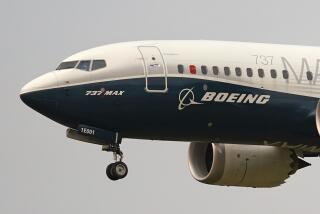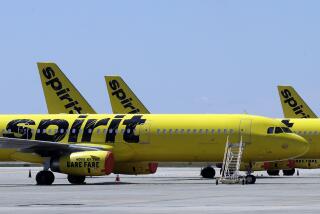Northwest’s Parent to Buy Republic : $884-Million Deal Would Make Airline 3rd-Largest Carrier
- Share via
MINNEAPOLIS — The parent company of Northwest Airlines has agreed to buy Republic Airlines for $884 million, officials of the two Minneapolis-based companies said Thursday.
The deal, if approved by shareholders and the federal government, will make Northwest the nation’s third-largest carrier behind United Airlines and American Airlines, said Steven G. Rothmeier, Northwest’s president and chief executive.
The agreement calls for Republic’s shareholders to be paid $17 per share by NWA Inc., Northwest’s holding company. Bob Gibbons, a spokesman for Republic, said about 52 million shares were outstanding, including warrants and debentures.
On the New York Stock Exchange, Republic closed Thursday at $14 a share before the announcement was made.
‘A Good Fit’
Hans J. Plickert, airline analyst with the E. F. Hutton brokerage, said late Thursday that there had been rumors about such a merger for several weeks.
“The merger is a good fit,” he said, “though in many ways the two overlap. They share routes from and to Minneapolis, where both have big hubs. They overlap in the northern tier of the country. The merger will eliminate competition in many cities, and we will have to see who will move into those markets. It is very unusual for one airline only to serve a market.”
The sale “addresses the needs of Republic’s three constituencies--shareholders, employees and customers,” said Stephen M. Wolf, Republic’s president.
The two carriers would have a combined work force of 30,000 employees and 298 jet aircraft, the two Minneapolis-based companies said in a joint statement.
“Because of the complete freedom of entry in all markets under the airline deregulation act, there should be no barrier to expeditious approval,” the statement said.
Many of the routes of the two airlines overlap, although Republic has a more complex domestic system and Northwest’s far-flung network across the Pacific extends to Japan, China and South Korea.
The combination is seen as a direct competitor to United Airlines, which is buying the historic Pacific routes of Pan American World Airways to link the Orient with United’s vast U.S. system. The latter touches all 50 states.
Northwest has flown the Pacific for decades and serves major U.S. cities.
United’s expansion has been stalled, however, by Japan’s refusal to grant United landing rights, claiming that it would be anti-competitive with transpacific Japan Air Lines, which serves several U.S. gateway cities.
The boards of Republic and NWA both approved the sale in separate meetings.
“We complement each other well,” Gibbons said. “Northwest has a fleet of wide-body aircraft that are ideal for long-distance routes. Republic has a fleet of short-haul, narrow-body aircraft.”
Northwest has 134 aircraft, 54 of which are wide-bodied Boeing 747s or McDonnell Douglas DC-10s. Northwest also operates 11 Boeing 757s and 65 Boeing 727s, and it has orders with Seattle-based Boeing for three 747-200s.
Republic has 168 aircraft, including three Boeing 757s with three more on order, 19 Boeing 727s, eight McDonnell Douglas MD-80s, 126 DC-9s and 13 Convair 580s, according to the companies’ statement.
The two companies said they granted each other “certain options and rights with respect to each other’s shares,” but they did not elaborate.
“The employees of Republic can be extremely proud of their performance in the development of a comprehensive, domestic hub system centered on the three cities of Minneapolis-St. Paul, Detroit and Memphis, (Tenn.)” Wolf said.
Republic, which cut wages in 1984 after losing $111 million in 1983 and nearly $100 million in the three previous years, reported an operating profit of $134 million for the first nine months of 1985, up from $90.7 million in the same period a year ago.
Wolf said in November that the airline had experienced a 33% expansion in its flight operations in that period, compared to an industry average of 7%.
Republic drastically restructured its flight schedule in 1985 to concentrate on three service hubs in the Twin Cities, Detroit and Memphis. That move, Wolf said, enabled Republic to channel passengers onto other Republic flights rather than lose them to other airlines.
Wolf said the change helped the airline increase its load factor--the percentage of seats filled by paying passengers--from 49.2% in October, 1984, to 59.9% a year later.
More to Read
Inside the business of entertainment
The Wide Shot brings you news, analysis and insights on everything from streaming wars to production — and what it all means for the future.
You may occasionally receive promotional content from the Los Angeles Times.










